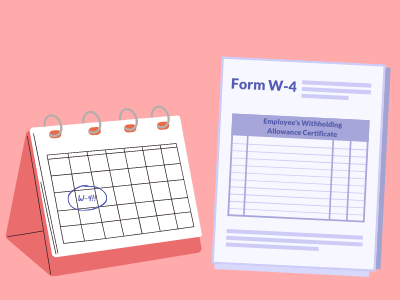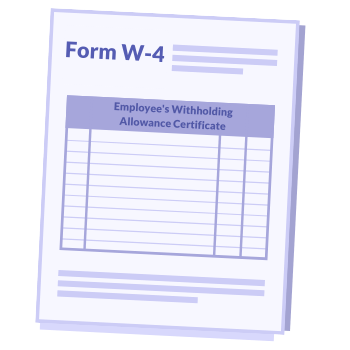Employer’s Guide: What is Form w-4 used for?
 Form W-4: Employee’s Withholding Allowance Certificate is an IRS form employers give new hires to fill out in order to determine the amount of tax to withhold from an employee’s paycheck. In the United States, taxpayers do not fulfill their tax liability all at once. Rather, they pay as wages are earned during the tax year. Their employer withholds the appropriate amount of tax and gives it to the IRS on the employee’s behalf. Information from Form W-4 guides the tax withholding process.
Form W-4: Employee’s Withholding Allowance Certificate is an IRS form employers give new hires to fill out in order to determine the amount of tax to withhold from an employee’s paycheck. In the United States, taxpayers do not fulfill their tax liability all at once. Rather, they pay as wages are earned during the tax year. Their employer withholds the appropriate amount of tax and gives it to the IRS on the employee’s behalf. Information from Form W-4 guides the tax withholding process.
According to the IRS, taxpayers should try to have their withholding match their actual tax liability. If the employer does not withhold a sufficient amount of money, the employee may be in for an unpleasant tax bill when she fills out her annual tax return. On the flip side, employees who have too much money withheld from each paycheck often do themselves a disservice. Yes, they receive the extra funds back upon reconciliation on their federal income tax return. Until that tax refund, though, they lose the ability to use that money for living expenses, paying off credit card debt, investing, and the like. It’s like giving the government an interest-free loan.
As an employer, you are responsible for asking someone to complete tax forms such as the W-4 upon starting a new job. You also should hold on to a copy of the employee’s withholding allowance certificate for at least four years in case the IRS wants to review it. Responsibility for the information inputted on the IRS form, however, falls to the individual employee.
Understanding the W-4
From an employer’s standpoint, the answer to the question “What is a W-4 form used for?” is basically “to collect withholding information from an individual employee.” This data, in turn, dictates how much of the worker’s earnings must be removed from his paycheck and paid directly to the government to fulfill tax obligations.
The W-4 form contains five steps. Not every step is applicable to every employee, so some sections might correctly remain blank.
Step 1
Here, every employee provides personal information. Make sure the name, address, and social security number entered match what payroll has on file.
This section also asks filing status: single or married filing separately, married filing jointly or qualifying widow(er), or head of household. Be certain only one box has been checked. Knowing someone’s correct filing status is vital because it determines the standard deduction and tax rates used to compute withholding.
Step 2
Only a person with more than one job or a spouse who works (and together filing jointly) completes this section. Following the specific instructions that pertain to one’s circumstance improves the accuracy of withholding. Some people will use the worksheet provided. Others will use the IRS’s tax withholding estimator.
Step 3
People claiming dependents need to complete this section. It provides instructions for determining the amount of the child tax credit and the credit for other dependents that the employee may be able to claim when he files his federal tax return. Like in step two, such information increases the accuracy of withholding. (Remember, from the perspective of the IRS, the goal is to come as close as possible to nothing owed and nothing refunded upon competition of the annual federal income tax return.)
Step 4
This optional section is the place for other adjustments that aren’t job-related. Job-related input, including projected earnings from self-employment, goes in step 2.
An employee who wants an additional amount of tax withheld for other income she expects this current year that won’t have automatic withholding enters the amount of other income in this area’s line A. This total frequently includes interest, dividends, and retirement income. People who complete this line often do so as an alternative to making estimated tax payments on their own. They find it easier to have the amount deducted from their paycheck rather than completing 1040-ES paperwork and making payments themselves.
If an employee expects to claim deductions other than the standard deduction and wants to reduce withholding, line B is the place to input this information. The Deductions Worksheet included with the W-4 assists in deriving the correct figure. Itemized deductions and other deductions such as for student loan interest and IRAs come into play here.
Step 4 line C is the place for the employee to request extra withholding from his paycheck. Someone may choose this voluntary reduction in order to receive a larger tax refund or reduce the amount of tax he expects to owe come tax time. Employers do not need to know the person’s reason. Rather, just be mindful of this additional amount the worker wants deducted each pay period beyond what you’re required by law to withhold.
Step 5
Make sure the employee signs and dates appropriately in this section. You’re responsible for completing the remaining items: employer’s name and address, first date of employment, and Employer Identification Number (EIN).
 Who needs to fill out a W-4?
Who needs to fill out a W-4?
Every employee fills out a W-4 upon starting a new job. People who completed form W-4 previously at another job need to do it again. The W-4 does not transfer between jobs. The employee should give the completed form back to the designated person at his new company, not send it directly to the IRS.
If a new hire fails to submit a W-4, remind him of its importance. Stress that a complete, accurate W-4 is in his best interest. Answers affect how much money gets withheld per paycheck.
An employee who does not provide information should not think this sets the stage for no taxes withheld from his paycheck. In fact, he might be setting himself up for more withheld than actually necessary. The IRS states to employers, “If an employee fails to give you a properly completed Form W-4, you must withhold federal income taxes from his or her wages as if he or she were single with no other adjustments. This means that a single filer’s standard deduction with no other entries will be considered in determining withholding.”
From time to time, employers may encounter someone who thinks he should not fill out a W-4 because he believes he is exempt from withholding. This status is rather uncommon, and HR might want to instruct the person to carefully consult IRS guidelines about the criteria for claiming exemption. Determination is the individual’s responsibility, including paying any later penalty for incorrect status.
If the employee still determines he wants to claim exemption, the employer will not withhold any income tax from the employee’s paycheck. However, the person should still complete a W-4 by filling out name, address, and social security number in section one. Then, he needs to write “Exempt” in the space below line C in section four to certify he meets exemption conditions. Finally, he should sign and date in section five.
In addition to the federal IRS form W-4, many states also require employers to issue and collect a state W-4 form for new hires. This document collects much of the same information as the federal version but is used to determine the correct amount of state tax to withhold from a paycheck.
Note that organizations do not need to give either federal or state W-4 forms to non-employees. Independent contractors are responsible for their own tax situation. They make estimated tax payments to the IRS on a quarterly basis. Companies for which they perform services do not perform income tax withholding on their behalf.
Performing a W-4 check-up
After employees fill out the W-4 at the start of a new job, they typically do not think much about the form again. A new one does not need completion each year. However, HR departments should encourage staff to periodically perform a W-4 check-up. An up-to-date W-4 ensures the amount of tax withheld from each paycheck best reflects current filing status.
In a W-4 check-up, an employee re-examines the information inputted on the initial W-4 form (or the one currently on file if he filled out a new one at some point during his time with the company). Financial situation changes and life changes such as different marital status, having a baby, children outgrowing dependent status, taking on a second job, and a spouse’s employment status can affect one’s tax situation and withholding allowances.
Employees can reassess their W-4 using the form and its worksheets. Many find it convenient to use the IRS’s Tax Withholding Estimator. This free online tool issues withholding recommendations based on information put in by the user. The estimator does not ask for identifiers such as name or social security number, and it does not save.
The start of a new year is a great time for employers to get current staff members to think about a W-4 check-up, perhaps mentioning it in a newsletter or at a general meeting. This allows implementing new tax withholding amounts as soon as possible for the upcoming tax year.
Another effective time to bring up a W-4 check-up is during tax season. Suggest that employees who upon filing their federal income tax return find themselves with either a big tax refund or a significant tax bill perform an evaluation.
Some seasoned staff members might be aware that the government recently revamped the W-4 form. Employers started using this new W-4 form in 2020. This version is given to new hires, and it contains the steps discussed earlier in this article. Existing workers do not need to submit a new form. If, however, they want to make withholding changes now or in the future, they need to do so on this updated version. Draw attention to the fact that it looks different than their original and should be read thoroughly and thoughtfully before completion.
More information on “What is a W-4 form used for?”
While employers should not act as tax advisors, they can direct workers with tax questions to potentially helpful resources. Some good places people can turn to for further answers to the question “What is a W-4 form used for?” include:
Publication 505, Tax Withholding and Estimated Tax (put out by the IRS and especially good for people with more complex tax situations)
Tax Withholding Estimator FAQs (a list of answers to common questions, available on the IRS website)
How to Use the IRS Withholding Estimator for Paycheck Checkup (a step-by-step YouTube video put out by the IRS)
Remind employees, too, that their tax preparer or personal financial advisor also can provide guidance on filling out the W-4. Such professionals can discuss how the information inputted for their client’s individual situation affects the both the money received each pay period and their annual federal income tax return.




